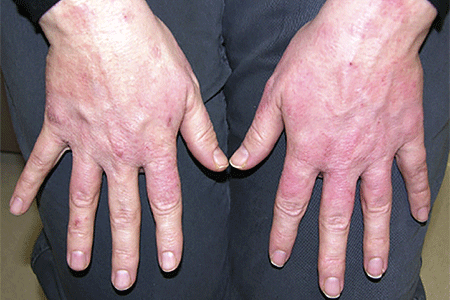Eczema types: Contact dermatitis overview
What is contact dermatitis?
When something that touches your skin either irritates it or causes an allergic skin reaction, you develop this skin disease. The first sign is often itchy skin, followed by a rash. You may also see blisters.
Contact dermatitis is not contagious, so you cannot give it to anyone else.
Because so many things can irritate our skin or cause an allergic skin reaction, contact dermatitis sends many people to see a dermatologist.
Dermatologists help their patients to get rid of contact dermatitis by:
Finding out what irritates the skin or causes an allergic reaction
Treating the itchy skin and rash caused by contact dermatitis
Helping their patients avoid what causes the contact dermatitis
Only by avoiding the cause can you get rid of contact dermatitis.
Contact dermatitis from frequent handwashing
You can reduce your risk of developing raw, irritated hands due to frequent handwashing by applying a fragrance-free hand cream after washing your hands and using a hand sanitizer with moisturizer.

While this may sound simple, finding the cause can be a challenge. More than 15,000 things that touch our skin can cause an allergic reaction. Some of the more common ones are fragrance and nickel, which are found in hundreds of products and everyday items. You can get a rash even if you only briefly touch something that causes an allergic reaction. This rash tends to appear hours or days after your skin touches what you’re allergic to.
Some people develop this rash only after sunlight hits their skin. For example, a bartender may squeeze plenty of lemons and limes while indoors and never develop a rash. When that bartender squeezes lemons and limes outdoors on a sunny day, a painful rash and large blisters develop where the sunlight hits the skin coated with juices.
With enough exposure, even everyday things that we touch can irritate the skin. If you dip your hands in water frequently throughout the day or often handle just-caught fish, you can develop an angry, itchy rash.
While some causes, such as exposure to water or handling fish, can be obvious, others take time to find. For example, in 2007, dermatologists in Finland were seeing hundreds of patients with rashes on their backs, buttocks, thighs, and arms. No cause could be found. Treatment with medication for contact dermatitis failed to help.
These patients often developed widespread itch and bumps. For some, the disease became so severe that they had to be hospitalized. Dermatologists in other European countries began seeing patients with the same signs and symptoms.
The race to find a cause was on. It took time to find the cause. Only when a few dermatologists started visiting the homes of their patients did they find the cause. All these patients, they discovered, had new furniture that came from a factory in Asia. Inside this furniture, the dermatologists found packets marked “mold-proof agent.”
Testing revealed that these packets contained a chemical that was causing the severe rash and body-wide reactions. Thanks to the investigations of these dermatologists, patients were able to avoid the cause. Equally important, no more people developed a rash from this chemical. The European Union banned it in consumer products.
While most people never develop such a serious reaction, this story shows that it can take time to find out what’s causing contact dermatitis.
When it comes diagnosing contact dermatitis and helping you avoid what causes it, dermatologists are the medical experts. If you have a rash that comes and goes or any other signs of contact dermatitis, seeing a board-certified dermatologist can help.
The sooner you see a dermatologist, the better. The longer you have contact dermatitis, the longer it will take to clear after your dermatologist finds the cause.
While an itchy rash is common, contact dermatitis can cause a range of signs and symptoms. You will find these along with more pictures that show you what contact dermatitis can look like at, Contact dermatitis: Signs and symptoms.
Image
Image used with permission of the Journal of the American Academy of Dermatology.
J Am Acad Dermatol 2020;83:1730-7.
References
Carol R. “Are you a rash whisperer?” Dermatol World. 2019:29(1):44-9.
Lammintausta K, Zimerson E, et al. “An epidemic of furniture-related dermatitis: searching for a cause.” Br J Dermatol. 2010 Jan;162(1):108-16.
Mowad CM, Anderson B, et al. “Allergic contact dermatitis: Patient diagnosis and evaluation.” J Am Acad Dermatol. 2016;74:1029-40.
Mowad CM, Anderson B, et al. “Allergic contact dermatitis: Patient management and education.” J Am Acad Dermatol. 2016;74:1043-54.
Rundle CW, Presley CL, et al. “Hand hygiene during COVID-19: Recommendations from the American Contact Dermatitis Society.” J Am Acad Dermatol 2020;83:1730-7.
Susitaival P, Winhoven SM, et al. “An outbreak of furniture related dermatitis ('sofa dermatitis') in Finland and the UK: history and clinical cases.” J Eur Acad Dermatol Venereol. 2010 Apr;24(4):486-9.
Usatine RP and Riojas M. “Diagnosis and management of contact dermatitis.” Am Fam Physician. 2010 Aug 1;82(3):249-55.
Written by:
Paula Ludmann, MS
Reviewed by:
Matthew Elias, MD, FAAD
Iltefat Hamzavi, MD, FAAD
Benjamin Stoff, MD, FAAD
Last updated: 12/14/20
 Think sun protection during Skin Cancer Awareness Month
Think sun protection during Skin Cancer Awareness Month
 How to care for your skin if you have lupus
How to care for your skin if you have lupus
 Practice Safe Sun
Practice Safe Sun
 Sunscreen FAQs
Sunscreen FAQs
 Fade dark spots
Fade dark spots
 Hidradenitis suppurativa
Hidradenitis suppurativa
 Laser hair removal
Laser hair removal
 Scar treatment
Scar treatment
 Botox
Botox
 Kids' camp - Camp Discovery
Kids' camp - Camp Discovery
 Dermatologist-approved lesson plans, activities you can use
Dermatologist-approved lesson plans, activities you can use
 Find a Dermatologist
Find a Dermatologist
 Why choose a board-certified dermatologist?
Why choose a board-certified dermatologist?